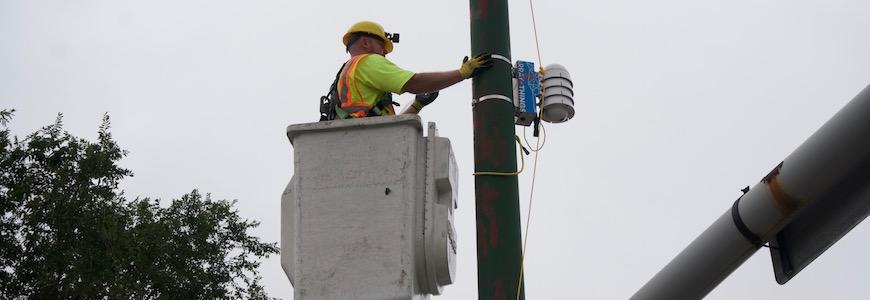Argonne National Laboratories (ANL), in partnership with the University, installed six Array of Things (AoT) nodes on August 29 throughout the city. Funded by a $3.1 million grant by the National Science Foundation, the project will continue until 2018, by which time a total of 500 nodes are expected to be installed and operational.
There are two components to each node: a white capsule containing sensors and an attached operating box functioning as a power source and control center. The nodes are designed with several environmental features; each is capable of measuring air and surface temperature, barometric pressure, levels of carbon monoxide, ozone, nitrogen and sulfur dioxide, as well as the level of ambient sound intensity within the immediate area. In addition, there are two cameras that collect data on vehicle and foot traffic.
The goal of collecting this information is to improve the city’s infrastructure, environment, and pedestrian safety. Although it is too early for ANL to report any data as of yet, they plan to upload it onto both the City’s data portal as well as their own platform, Plenar.io. Data for nodes that will be installed in other cities in the future will be also uploaded to Plenar.io. As AoT grows, so will Plenar.io, and the system will become a global network of information utilizing the AoT project as its medium. During this process, all of the information will be accessible to the public.
Public access to the data AoT collects is important to the initiative. “We’re very interested in public engagement with this project because we see the project, we see the nodes, we see the data as being a public utility first and foremost,” said Rob Mitchum, media correspondent for the AoT Project.
According to Mitchum, Pilsen was given preference as an installation location because of the public’s concerns regarding the community’s air quality. Due to the close proximity of multiple power plants and nearby factories, various community organizations have formed and worked with both the City and CTA to combat the environmental damage through implemented policies. By utilizing the nodes, they would have more substantial evidence to support legislative change within their communities.
Similar concerns have arisen in neighboring communities during the multiple public meetings the AoT team has held before the official installations. Being able to hear the various types of problems people bring as well as the creative uses suggested for the nodes embodies the ideal behind the project, Mitchum says. The aspect of providing open data to be used by the public is parallel to taking suggestions from local communities for potential improvements.
Douglas Pancoast, an associate professor at the School of the Art Institute of Chicago (SAIC), argues that this degree of openness also influenced the nodes’ design. Before being finalized and manufactured at Product Development Technologies, the enclosure design of the nodes was originally designed at SAIC. The nodes were continually tested under different conditions both on campus and at ANL for over 18 months.
The nodes are still in their beginning stages. According to Pancoast, the data will not only benefit the city but also provide insight into how the nodes could be improved for future generations. In light of this, Pancoast added, the design team is eager to see how the nodes perform within the city.
Multiple partnerships are backing the project. Vision Zero Chicago, an interdepartmental initiative dedicated to increasing roadway safety, strongly supports the potential applications of AoT. By collaborating with the Chicago Department of Transportation, Vision Zero hopes to gain a better understanding of travel behaviors within the city in order to improve pedestrian safety and congestion management. The implementation of AoT will be highly encouraged by Vision Zero Chicago, among other engineering and educational initiatives contained within their three-year action plan, which will launch early next year.








